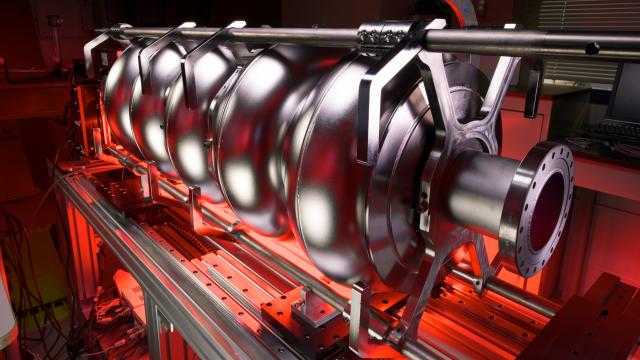Construction began last week on a new particle accelerator at Fermi National Accelerator Laboratory in Illinois. The new project will power Fermilab’s flagship neutrino-studying accelerator experiment.
The Proton Improvement Plan II, formally approved by the Department of Energy last summer, includes plans for the highest-energy linear particle accelerator to accelerate a continuous stream of protons using superconducting radio-frequency cavities. That’s a mouthful—so it’s best to think of it as a central component to the American particle physics laboratory.
PIP-II will “enable other particle physics experiments for many decades,” Lia Merminga, the director of the project from Fermilab, told Gizmodo.
At present, Fermilab has a 152.40m-long superconducting radio-frequency linear accelerator that can send protons to 400 mega-electronvolts (MeV), or around 70 per cent the speed of light. The PIP-II upgrade will include a 213.36m-long accelerator that doubles the energy to 800 MeV, 84 per cent the speed of light.
This is still a small fraction of the energies of particles produced at the Large Hadron Collider, but rather than producing bunches of particles the PIP-II upgrade will produce a continuous beam.
Similar to how humming into a cup at just the right pitch makes your voice sound louder, linear accelerators amplify electric fields using resonance. There’s an electric field inside a cavity made from a superconductor and cooled by liquid helium, excited by a radio-frequency source with the same resonant frequency as the cavity. This increases the amplitudes of the electric fields, accelerating the charged particles that pass through.
Though the accelerator has plenty of potential uses, it’s not the protons you should be most interested right now — instead, these protons will hit a graphite target, producing the incredibly low-mass, mysterious particles called neutrinos.
Trillions of these neutrinos will travel 1,287km underground to a detector in South Dakota as part of the Deep Underground Neutrino Experiment, or DUNE. DUNE’s scientists hope to understand the nature of these particles, like why they oscillate between their three possible types, seemingly by magic.
PIP-II is also notable as the first Department of Energy-funded accelerator project to be built with significant international contribution. About a quarter of the project’s funding will come from other countries, explained Merminga, including France, India, Italy, and the United Kingdom.
The project is just one part of the new neutrino experiment, but together with the DUNE detectors and the Long-Baseline Neutrino Facilities that will house the detectors, it will be an important American particle physics experiment to keep your eye on.
